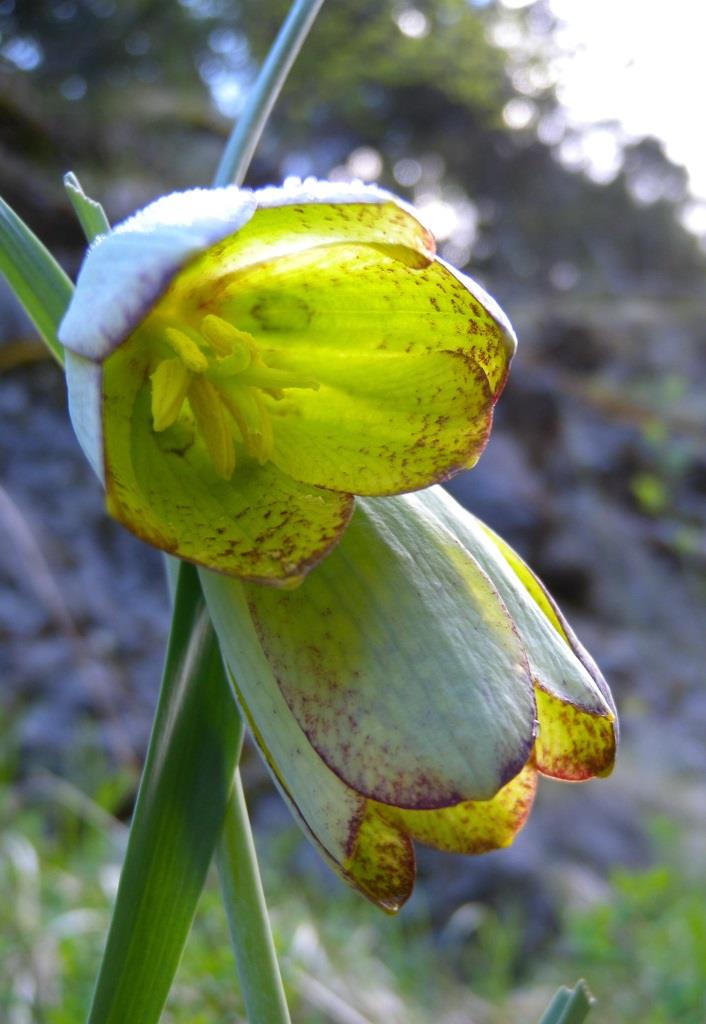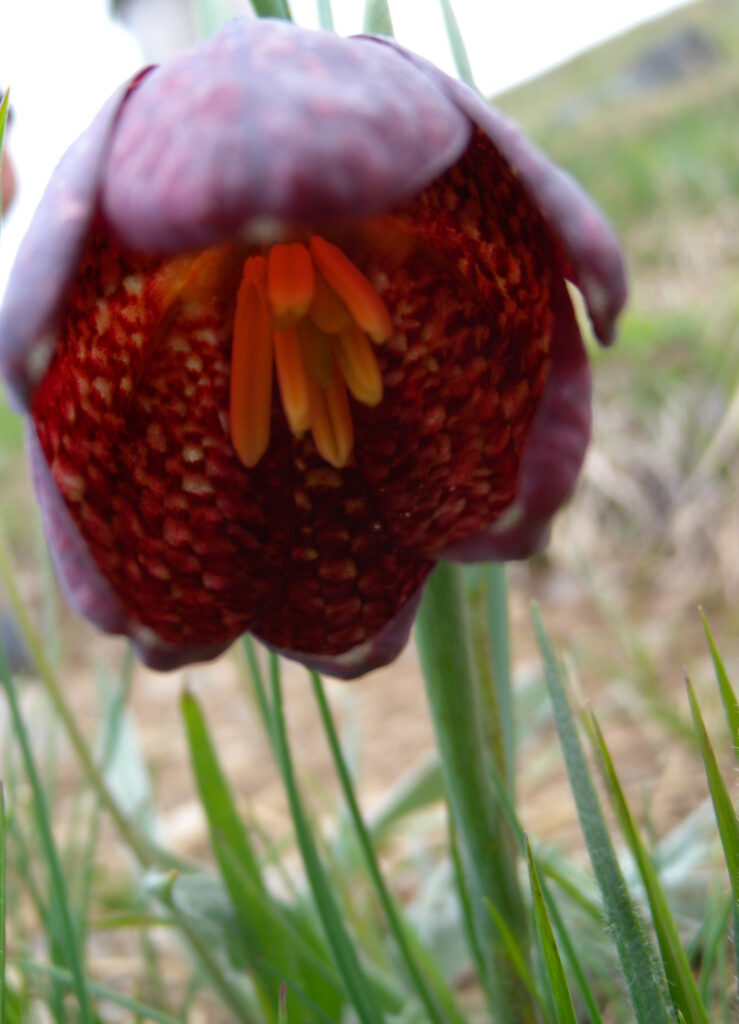In our regular postings on Facebook, occasionally here, we have featured at least three times Clarence’s watercolour designs based on the fritillary. It’s an extrordinarily beautiful bell-shaped brightly-patterned wild flower of the Alps – all its varieties inspired Clarence to exceptional artistic creations.This article brings his various fritillary creations on one page, and photos by Elisabette Massardo of the same flower in Clarence’s Alps.
When one thinks of Arts and Crafts, one thinks of its greatest exponent, the artist and writer William Morris (1834–1896, just 10 years older) who was in his stride in the 1860s when Clarence was going through university. Morris’s use of floral themes to make designs for wallpaper and china might have inspired Clarence to use his brushwork talents to decorate the vellum books and other items round the house. Many of Clarence’s patterns, such as those which dominate the collection in the Fitzwilliam Museum in Cambridge, are formed in geometric patterns such that are easily adopted by today’s design-hungry consumers as table mats, tea cloths and kitchen tiles. The Arts and Crafts movement was intensified by the writings of John Ruskin (1819–1900), among others, the same Ruskin who was a friend of Clarence’s father and a frequent guest at the family home in Herne Hill. It is likely that Clarence knew from the world around him that there was value in painted creativity other than just landscapes and portraits on canvas.

You can learn more about Clarernce’s art in Susie Bicknell’s paper which you can dowbload here: Clarence Bicknell – His Art
1) Fritillaria involucrata
On the right we show the symmetrical pattern based on Fritillaria Involucrata by Clarence Bicknell in one of his albums in the Fitzwilliam Museum, University of Cambridge. He has used the square shapes of the petals to make small decorative chess-boards; they also give the impression of dice, and he uses this idea in one of his illustrated fantasy poems (see paragraph 4 below).
Fritillaria Involucrata is number 23 in our series of floral designs by Clarence Bicknell
Fritillaria Involucrata is an attractive flower of the Liliaceae family, endemic and rare growing only in South-western Alps, between 1000 and 2000 metres and flowering from April to June. It has narrow leaves and pale lime green bells chequered all over in darker green or in pink-flesh-purple tones. The edges of the petals are picked out in red-brown. Fritillaire Involucrée in French and Meleagride piemontese In Italian. It is one of the Fritillaria species from the Alps which is closest to the Mediterranean F messanensis from which it differs in the lack of a fascia and its entirely opposite leaves.
The three photographs of Fritillaria Involucrata(below) were taken by Elisabetta Massardo, mountain walker, amateur botanist and Companion of the Clarence Bicknell Association, in the high Val Roya in May 2018.
2) Fritillaria moggridgei

Clarence, early in his life of botanical art in Bordighera, consulted a book of flowers by John Traherne Moggridge, Contributions to the flora of Mentone, and to a winter flora of the Riviera, including the coast from Marseilles to Genoa published in 1871. Moggridge said in his book that the list was incomplete and he exhorted others to complete it; Clarence took this advice to heart; by 1884 he had completed over one thousand botanically-accurate water-colours which were the basis for his illustrated book Flowering Plants and Ferns of the Riviera and Neighbouring Mountains which was published in London in 1885. Valerie Lester in MARVELS: The Life of Clarence Bicknell, pages 64 to 65 and elsewhere, develops on the respect Bicknell had for Moggridge. The fritillary named after Moggridge drew his attention. Fritillaria moggridgei (strictly a supspecies Fritillaria tubiformis ssp. moggridgei) (has a yellow flower) (Liliacee family, fritillaria tubiformis Gren, & Godr. subspecies moggridgei) is also known as Golden snake Head in English. The yellow subspecies of the above which grows in different colonies so could be justified as a separate species.
Clarence adored the fritillaries and he used them often in his art. Clarence painted this flower in watercolour with a matching arts-and-crafts surround in the Casa Fontanalba Visitors’ Book (see image) on the right of the page for 1908.
Fritillaria tubiformis ssp. moggridgei. Yellow petals with slight brown points. Flowers in June and July, very attractive. Endemic to the south-western Alps, Ligurian & Maritime Alps, grows between 1000 and 2600 metres altitude on silicious terrain. The flowers are often found close to the Rifugio Garelli in Valle Pesio at 2000 metres (Pian del Lupo). Here there is a Botanic Station in the Parco Naturale Marguareis which in the past was named after both Burnat and Bicknell but which in 2018 was renamed in Clarence Bicknell’s name solely.
Fritillaria moggridgei is number 33a in our series of floral designs by Clarence Bicknell
These photographs of the flowers (below) were taken by Elisabetta Massardo (our friend and Companion of the Clarence Bicknell Association whom we thank) close to the Botanic Station, Valle Pesio and in the valleys around.
3) Fritillaria burnati

This Fritillary is named after Emile Burnat, the Swiss botanist who also featured large in Clarence Bicknell’s life. Bicknell, after taking up residence in Bordighera, developed an important friendship with Burnat, who lived at Nant near Vevey in Switzerland. Both were interested in the flora of the Maritime Alps, and published botanical works: Bicknell’s Flowering plants and ferns of the Riviera and neighbouring mountains (right) appeared in 1885 and his Flora of Bordighera and San Remo in 1896, while Burnat’s magnum opus La Flore des Alpes Maritimes was published in six volumes from 1892 to 1917, with another volume published posthumously in 1931. In the archives of the scientific correspondence of the Conservatoire et Jardin Botaniques de la Ville de Genève are about 690 documents (letters and postcards) sent by Bicknell to Burnat in the period from 1886 to 1917; during this period of 32 years Bicknell sent an average of 21 letters per year, with the highest frequency in 1889 when he sent 45. Their friendship was botanical at the core but personal in the amount of details Bicknell wrote about his plans, the people round him and events in his daily life. The Vice-Chairman of the Clarence Bicknell Association, Graham Avery, develops on the Bicknell-Burnat relationship and transcribes the bulk of he correspondance in his paper at https://clarencebicknell.com/wp-content/uploads/burnat_letters_from_bicknell.pdf
Emile Burnat has been further honoured in the area; the Centre of Vegetal Biodiversity at Chiusa Pesio in Valle Pesio, representing one of “Aree protette Alpi Marittime”, has been renamed Centro per la Biodiversità Vegetale “Emile Burnat”.
The fritillary named after Emile Burnat is Fritillaria burnati (Liliacee family, fritillaria meleagris subsp, burnatii). It has a very attractive brown-purple red flower and flowers in June and July. It is endemic to the south-western Alps, Ligurian & Maritime Alps and grows between 1000 and 2600 metres altitude on silicious terrain. Found close to the Rifugio Garelli in Valle Pesio at an altitude of 2000 metres (Pian del Lupo). See Graham Avery’s note at
https://clarencebicknell.com/wp-content/uploads/botanical_reserve_burnat_bicknell_avery.pdf
Clarence adored the fritillaries and he used them often in his art. Clarence painted this Fritillaria burnati in watercolour with a matching arts-and-crafts surround in the Casa Fontanalba Visitors’ Book (see image) on the right of the page for 1907.
Fritillaria burnati is number 33a in our series of floral designs by Clarence Bicknell.
The photographs of the Fritillaria burnati flowers, below, were taken by Elisabette Massardo (our friend and Companion of the Clarence Bicknell Association whom we thank) in the Maritime Alps in May 2018.
4) Clarence’s fritillaries in one of his fantasy albums
Several of the seven vellum-bound albums in the Fitzwilliam Museum are fantasy stories, apparently for children, and illustrated with floral motifs or surround in his arts-and-craft style. The poem and image shown here refers in the text to the square features of the petals of Fritillaria involucrata as “dice”, those used for playing games and gambling… that’s why Clarence’s vivid imagination leads him to bring the flowers to life in the story; “Some of the crowd whispered that their ancestors were gamblers”! The two fritillaries here are probably Fritillaria moggridgei (left) and Fritillaria burnati (right).

Here is the complete text of this page, referring to the two fritillaries of course…
“They seemed to be twins. One was very dowdily dressed, the other in bright yellow, but both a number of strange marks or sports something like dice. They did not hold up their heads and you could not see faces or the honey-pots they carried. Some of the crowd whispered that their ancestors were gamblers and now the children are all branded with these signs. They said
Fritillaries are we!
Some people call us snake-heads:
It is not kind, but we don’t mind:
We only bow and shake our heads
And off we gambol free.”
( Image from albums in the Fitzwilliam Museum, University of Cambridge, whom we thank. The albums were donated to the Fitzwilliam by Marcus’s uncle Peter Bicknell in 1980. Fitzwilliam image reference PD.11-1980_f14_1_201704_sjc_dc1288). The fritillaries in Clarence’s fantasy album is number 33c in our series of floral designs by Clarence Bicknell
Acquarello e poesia di Clarence Bicknell (1842-1918 )
‘Sembravano due gemelle Una era vestita un poco trasandata, l’altra di un giallo brillante ma tutt’e due con un gran numero di strani segni e puntini, come nei dadi. Non tenevano sù la testa e non potevi vedere i loro visi o il sacchetto di polline che portavano. Qualcuno dalla folla sussurrava che i loro avi erano giocatori d’azzardo, i loro figli erano tutti marchiati con questi segni. Dicevano:
Fritillarie noi siamo!
qualcuno ci chiama teste di serpente
Non è gentile, ma a noi non importa
Ci inchiniamo e scuotiamo la testa
E facciamo capriole, libere !








